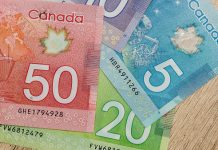- Retail sales surged by 1.3% in November, defying Statistics Canada’s preliminary forecast which called for a flat reading. Adjusting for price effects, the performance was relatively similar with the volume of sales up 1.2%.
- October’s gain was revised lower to 0.1%, down from 0.4% reported originally. Taken together with today’s result, this leaves retail sales up 7.5% from the year-ago level. Looking ahead, the agency’s flash estimate points to a 2.6% decline in December.
- Sales at vehicle and parts dealers and at gasoline stations were among the handful categories which underperformed, declining by 0.9% and 1.6%, respectively. In volume terms, gasoline sales were even weaker, down 2.2%. Sales were also lower at clothing and accessories (-1.6%) and health and personal care stores (-0.5%).
- Core sales, which exclude sales of autos, parts and gasoline, rose at an even faster pace than the headline, increasing by 2.6%.
- Outsized gains at food and beverage stores (+5.9%) – the largest one month increase since the lockdown in March – supercharged core sales in November. Electronics and appliance stores were also among the outperformers, with sales rising by 4.5%. Gains were robust in all remaining categories as well, ranging from 0.8% for furniture stores to 2.2% for building materials and garden equipment suppliers.
- Following a drop in October, online sales rose by 2.7% in November with consumers likely shifting their shopping forward to avoid holiday shipping delays. Compared to a year ago, online sales were up a whopping 75.9%.
- Regionally, sales were higher in nine out of ten provinces, declining only in Manitoba (-3.1%). The strongest advances were seen in Atlantic provinces, with gains ranging from 6% in New Brunswick to 3.6% in Nova Scotia. Quebec also had a solid month, with sales up 2%. By comparison, the performance was more muted in Ontario and British Columbia, with sales up just 0.9% and 0.8%, respectively.
Key Implications
- November’s retail sales report surprised to the upside. November sales were likely boosted by robust pre-holiday shopping, with consumers stocking up on gifts and food supplies well ahead of time in anticipation of delays and tighter restrictions. This is re-affirmed by strong sales at food & beverage and electronics & appliance stores.
- However, as highlighted in our recent report, TD aggregate spending data suggests that consumers have tightened their purse strings in December on the back of virus resurgence, more stringent government restrictions, and the pull forward of activity to November. Google mobility data also echoes this with travel to retail and recreation locations slumping significantly in the first two weeks of January.
- All in all, given the worsening health crisis, consumer spending will likely take a step back in the near-term. However, spending is expected to rebound as restrictions are lifted and vaccines become widely available. Excess household savings and pent-up demand provide an upside to consumer spending in the second half of the year.















